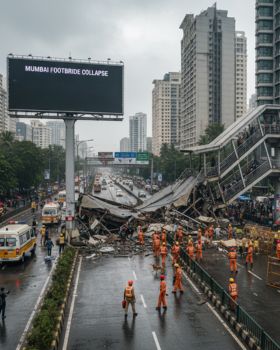
Disclaimer:
This blog post is intended for informational purposes only and is based on publicly available information about the Rana Plaza collapse. The aim is to highlight the importance of workplace safety, contractor management, and safety induction practices. While every effort has been made to ensure accuracy, SHEQ Network does not assume responsibility for any errors or omissions in the content. This article does not assign legal liability to any specific parties involved in the incident. References to third-party organizations or events do not imply endorsement or affiliation. Readers are encouraged to consult official reports or sources for more detailed insights and should seek professional advice when implementing safety systems or protocols.
On April 24, 2013, the world witnessed one of the deadliest industrial tragedies in modern history — the Rana Plaza collapse. Located in Savar, near Dhaka, Bangladesh, this eight-story building housed multiple garment factories, a bank, and retail shops. Despite visible cracks detected the day before, thousands of garment workers were ordered back to work under threat of losing their jobs. The building collapsed during the morning rush, killing over 1,100 people and injuring more than 2,500 others.
The Bangladesh factory collapse shook the global apparel industry and triggered widespread concern about working conditions, labor rights, and contractor accountability in supply chains. For companies and contractors worldwide, this incident serves as a haunting case study in why proper safety induction and contractor management procedures are non-negotiable.
The Cost of Neglect: What Went Wrong at Rana Plaza
The Rana Plaza collapse was not caused by a natural disaster or a freak accident. Instead, it was the result of multiple layers of negligence:
- The building was illegally constructed with additional floors not designed to bear the load of heavy industrial equipment.
- Despite warnings about dangerous cracks, workers were forced to return to unsafe conditions.
- There was no formal hazard communication or induction process for workers to understand the risks.
- Contractors and subcontractors prioritized deadlines over safety.
This tragedy underscores that the lack of safety protocols, poor contractor oversight, and absence of clear communication can be fatal.
Why Safety Induction Is a Foundational Requirement
When new employees or contractors start a job — especially in high-risk industries like construction, manufacturing, or logistics — they need to understand how to identify and respond to hazards, what safety protocols to follow, and how to report unsafe conditions.
A structured safety induction is the first line of defense in building that knowledge. It doesn’t just tick a compliance box — it can save lives.
In a case like the Bangladesh factory collapse, many workers were unaware of their rights or the severity of the building’s condition. Had there been a transparent induction and escalation procedure, more workers could have refused unsafe work without fear of losing their income.
The Rise of Online Induction Software
Traditional, paper-based safety inductions are often inconsistent, outdated, and difficult to verify. Modern online induction software is designed to address these shortcomings by offering:
- Standardized content across all sites and teams
- Remote access from any device
- Automated recordkeeping for audits and inspections
- Interactive learning tools that improve knowledge retention
This technology could help prevent scenarios like Rana Plaza by ensuring every worker receives consistent, up-to-date safety guidance before stepping onto a site.
For multinational companies managing global contractor networks, the benefits of online induction software extend to risk reduction, training transparency, and faster onboarding.
Managing Contractor Safety with Precision
One of the root causes of the Bangladesh factory collapse was the absence of a formal contractor management process. Subcontractors made decisions without oversight, and factory compliance with safety regulations was minimal at best.
This is where online contractor induction systems play a critical role. These tools enable organizations to:
- Collect and review contractor qualifications before site entry
- Deliver pre-approved induction modules tailored to specific risks
- Ensure contractors agree to and understand key site rules
- Document and verify compliance without relying on paper trails
These systems do not monitor every task in real time, but they do provide a framework for informed decision-making, risk flagging, and consistent onboarding.
By equipping contractors with relevant safety knowledge and expectations, organizations can help ensure contractors make safer choices — especially when pressured by deadlines or external demands.
Lessons for Every Industry
Though the Rana Plaza collapse occurred in the garment sector, its lessons apply across industries. Whether it’s construction, energy, logistics, or manufacturing, organizations that rely on third-party labor must:
- Demand transparency from their contractors
- Ensure every worker is properly inducted
- Respond to early warning signs — such as reports of damage, risk, or worker concerns
- Establish a safety culture where people are not afraid to speak up
The Bangladesh factory collapse proved that in the absence of these fundamentals, even minor oversights can escalate into mass casualties.
Real-World Change Sparked by Tragedy
Following the collapse, global brands and NGOs formed alliances to improve factory oversight in Bangladesh, including the Accord on Fire and Building Safety and the Alliance for Bangladesh Worker Safety. These groups introduced inspection protocols, safety upgrades, and worker training programs that could help prevent future disasters.
But the burden of responsibility shouldn’t only fall on regulatory groups. Every company working with contractors — no matter the industry or location — has the power to implement better induction, communication, and compliance practices today.
Conclusion: Safer Workplaces Start with Smarter Systems
The Rana Plaza collapse was a catastrophic event that forever altered how the world sees labor safety, particularly in developing economies. It exposed a painful truth — that lack of induction, lack of training, and poor contractor accountability can cost lives.
To move forward responsibly, organizations must embrace tools and practices that foster accountability, education, and compliance from day one.
Modern solutions like:
- Online contractor induction
- Online induction software
- Safety induction programs
…aren’t just tools for compliance. They are opportunities to create a safer and more informed workforce, where tragedies like the Bangladesh factory collapse are never repeated.
By integrating these tools into your operations, you create a more transparent, traceable, and proactive approach to contractor safety — without overpromising on capabilities. These systems don’t verify every task or monitor in real time, but they do offer a powerful layer of protection by ensuring the right people have the right information at the right time.
🔗 Learn more at sheqnetwork.com and transform the way you manage contractor safety today.
👉 Ready to see it in action? Book your free demo here!
Ready to transform? Contact us today at info@sheqnetwork.com or call us at +353 21 4536034 for a personalized demo!



